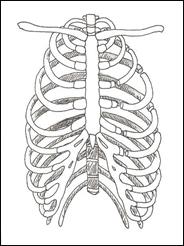Flail Chest
A flail segment occurs when two or more ribs are fractured in two or more places, creating a “free floating” segment of the thoracic wall. This has significant implications for the mechanics of ventilation, but perhaps of more concern is the degree of force this injury represents. For a young person to sustain a flail segment, there will have been a significant transfer of energy, and this will also cause pulmonary contusions, though this may not be immediately apparent, it needs to be anticipated and appropriate management initiated.

Pictorial representation of a flail chest
Recognition of a Flail Chest
One of the key features of a flail segment is the extreme degree of associated pain. This should raise the possibility of a flail segment if this has not already been considered. There may be palpable crepitus, and there will probably be tachypnoea and shallow breaths.
Traditionally, examination for paradoxical movement of a flail segment. (during inspiration, the chest wall moves upwards and outwards, but the free floating flail segment is paradoxically pulled inwards as a consequence of the negative intrathoracic pressure) was taught. In reality, the chest wall musculature initially splints the flail segment, and so paradoxical movement may not be seen.
Management of a Flail Segment
- ABCDE
- Oxygen
- Appropriate analgesia